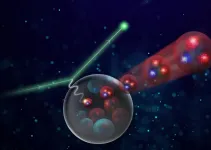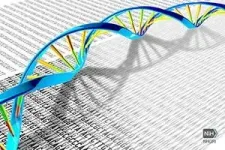(Press-News.org) Born in food web ecology, the concept of trophic levels -- the hierarchy of who eats who in the natural world -- is an elegant way to understand how biomass and energy move through a natural system. It's only natural that the idea found its way into the realm of aquaculture, where marine and freshwater farmers try to maximize their product with efficient inputs.
"It's often used as a measure of how sustainable it is to harvest or consume that species," said Rich Cottrell(link is external), a postdoctoral researcher at UC Santa Barbara's National Center for Ecological Analysis & Synthesis (NCEAS). As plants (level 1) become food to plant eaters (level 2), who in turn are consumed by carnivores (level 3) and so on, the amount of energy required to support the same weight of organisms increases, he explained. As a result, species at levels 4 or 5, such as tuna, require far more energy per pound than would species in the lower trophic levels. It's the same reason vegetarian diets are often considered to be more sustainable than meat-eating ones.
"In the same manner, trophic level measures are now being recommended in policy settings for use as an indicator of the sustainability of fish farming, or aquaculture," Cottrell said. The lower the trophic level, the more sustainable the species is considered to be, and so policy often calls for more farming of low-trophic species.
However, argue Cottrell and fellow aquaculture experts in a paper(link is external) published in the journal Reviews in Aquaculture, at this time of increasing complexity and sophistication in the aquaculture sector, the same simplicity that makes trophic levels attractive as a measure of sustainability also makes them insufficient.
The causes for that have largely to do with how today's farmed fish are fed.
"Most of the fish and invertebrates that we farm for food are produced using human-made feeds," Cottrell explained. "But these feeds are constantly changing, and so the meaning of farmed trophic levels is changing through time." For instance, he pointed out, salmon are considered to be at a higher trophic level because their naturally carnivorous diets would require large amounts of fishmeal and oil, but advances in feed and manufacturing have reduced the proportion of fish-based ingredients to 10-15% in modern salmon diets. Meanwhile, herbivorous species such as carp and tilapia have been found to respond favorably to small amounts of fishmeal in their feed.
"In reality, they're now farmed at similar trophic levels," Cottrell said. "The line between 'low' and 'high' trophic levels will continue to blur with innovation."
The trophic level concept misses still another important aspect of aquaculture sustainability in the realm of feed and resource efficiency, or how efficiently the farmed animals convert what they are fed into edible food.
"This is not well explained by trophic level," Cottrell said, adding that despite their high trophic placement, many carnivorous farmed fish could be more feed-efficient than their naturally carnivorous counterparts. And because aquaculture is increasingly turning to agriculture to provide replacements for fishmeal and oil, the promise of sustainability might be an empty one.
"Replacing fish-based ingredients with crops has led to a dramatic reduction in the trophic level of fed aquaculture species, but we know very little about how sustainable it is to increase pressure on global agricultural systems," he said.
As the global aquaculture sector strives to meet the growing demand for farmed seafood, the researchers say it's time to rethink the use of trophic levels as a rule for and measure of sustainability. Stipulating low trophic level aquaculture recommendations may not be successful in promoting greater sustainability, Cottrell said. Boosting the supply of mussels, for instance, may not fulfill increasing demand for shrimp or salmon.
"It behooves us to find a way to ensure that for high-demand products, we produce these in the most environmentally efficient and socially responsible way possible," he said. "Trophic levels will not get us there."
Fortunately, there are efforts at more nuanced sustainability assessments, such as voluntary certifications through the Aquaculture Stewardship Council or Best Aquaculture Practices, which examine the impacts of aquaculture at the farm level and through supply chains.
"Greater support for these programs and incentives for producers from various regions and production systems to join them would be a far more robust way to strengthen the sustainability of the aquaculture sector going forward," Cottrell said.
INFORMATION:
Research for this paper was conducted also by Halley E. Froehlich, Caitlin D. Kuempel, Benjamin S. Halpern and David R. Williams at UCSB; Marc Metian at the International Atomic Agency, Monaco; Julia Blanchard and Kirsty L. Nash at the University of Tasmania; Nis Sand Jacobsen at the Technical University of Denmark; Peter B. McIntyre at Cornell University; Lex Bouwman at Utrecht University; Jessica Gephart at American University; Daniel D. Moran at the Norwegian University of Science and Technology and Max Troell at the Royal Swedish Academy of Sciences.
Hypertrophic cardiomyopathy (HCM) is a cardiovascular disease characterized by thickening of the left ventricle, otherwise known as the main squeezing chamber of the heart. HCM is best known for causing sudden death in athletes but can occur in persons of any age, often without symptoms. While frequently discussed in the context of genetics, most patients with HCM do not have a known genetic variant. Investigators from Brigham and Women's Hospital uncovered a means to study the complexity of this disease beyond the identification of individual genes. This new approach offers a path toward treating HCM using individualized medicine. ...
While protons populate the nucleus of every atom in the universe, sometimes they can be squeezed into a smaller size and slip out of the nucleus for a romp on their own. Observing these squeezed protons may offer unique insights into the particles that build our universe.
Now, researchers hunting for these squeezed protons at the U.S. Department of Energy's Thomas Jefferson National Accelerator Facility have come up empty handed, suggesting there's more to the phenomenon than first thought. The result was recently published in Physical Review Letters.
"We were looking to squeeze the proton such that its quarks are in a small-size configuration. And that's a pretty tough ...
A University of Oklahoma-led study published in 2020 revealed that both area and plant growth of paddy rice is significantly related to the spatial-temporal dynamics of atmospheric methane concentration in monsoon Asia, where 87% of the world's paddy rice fields are situated. Now, the same international research team has released a follow-up discussion paper in the journal Nature Communications. In this paper, the team identifies the limits and insufficiency of the major greenhouse emission database (EDGAR) in estimating paddy rice methane emissions.
"Methane emission from paddy ...
EL PASO, Texas - A study by physiology researchers at The University of Texas at El Paso found that El Paso's stay-at-home ordinance due to the COVID-19 pandemic had positive effects on the health and well-being of the region's residents.
Despite a shutdown of gyms and movement restrictions on non-essential activities, residents increased their fitness activity and closely monitored their food and nutrition intake, said Cory M. Smith, Ph.D., assistant professor of kinesiology in UTEP's College of Health Sciences and the study's principal investigator.
More than 1,300 El Paso and ...
Researchers at the University of Maryland School of Medicine (UMSOM) co-authored a study, published today in the journal Science, that details the sequencing of 64 full human genomes. This reference data includes individuals from around the world and better captures the genetic diversity of the human species. Among other applications, the work will enable population-specific studies on genetic predispositions to human diseases as well as the discovery of more complex forms of genetic variation.
Twenty years ago this month, the International Human Genome Sequencing Consortium announced the first draft of the human genome reference sequence. The Human Genome Project, as it was called, required 11 years of work and involved more than 1000 ...
Psychologists have long found that people behave differently than when they learn of peers' actions. A new study by computer scientists found that when individuals in an experiment about autonomous vehicles were informed that their peers were more likely to sacrifice their own safety to program their vehicle to hit a wall rather than hit pedestrians who were at risk, the percentage of individuals willing to sacrifice their own safety increased by approximately two-thirds.
As computer scientists train machines to act as people's agents in all sorts of situations, the study's authors indicate that the social component of decision-making is often overlooked. This could be of great consequence, note the paper's authors who show that the trolly problem -long shown to be ...
States regularly use administrative records, such as motor-vehicle data, in determining whether people have moved to prune their voter rolls. A Yale-led study of this process in Wisconsin shows that a significant percentage of registered voters are incorrectly identified as having changed addresses, potentially endangering their right to vote.
The study, published in the journal Science Advances, found that at least 4% of people listed as suspected "movers" cast ballots in 2018 elections using addresses that were wrongly flagged as out of date. Minority voters were twice as likely as white voters to cast their ...
The COVID-19 virus holds some mysteries. Scientists remain in the dark on aspects of how it fuses and enters the host cell; how it assembles itself; and how it buds off the host cell.
Computational modeling combined with experimental data provides insights into these behaviors. But modeling over meaningful timescales of the pandemic-causing SARS-CoV-2 virus has so far been limited to just its pieces like the spike protein, a target for the current round of vaccines.
A new multiscale coarse-grained model of the complete SARS-CoV-2 virion, its core genetic material and virion shell, has been developed for the first time using supercomputers. The model offers ...
Litter is not only a problem on Earth. According to NASA, there are currently millions of pieces of space junk in the range of altitudes from 200 to 2,000 kilometers above the Earth's surface, which is known as low Earth orbit (LEO). Most of the junk is comprised of objects created by humans, like pieces of old spacecraft or defunct satellites. This space debris can reach speeds of up to 18,000 miles per hour, posing a major danger to the 2,612 satellites that currently operate at LEO. Without effective tools for tracking space debris, parts of LEO may even become too hazardous for satellites.
In a paper publishing today in the SIAM Journal on Imaging Sciences, Matan Leibovich (New York University), George Papanicolaou (Stanford University), and Chrysoula Tsogka (University of California, ...
The unprecedented cost of the 2018 Kilauea eruption in Hawai'i reflects the intersection of distinct physical and social phenomena: infrequent, highly destructive eruptions, and atypically high population growth, according to a new study published in Nature Communications and led by University of Hawai'i at Mānoa researchers.
It has long been recognized that areas in Puna, Hawai'i, are at high risk from lava flows. This ensured that land values were lower in Puna--which lies within the three highest risk lava hazard zones 1, 2 and 3--which actively promoted rapid population ...




